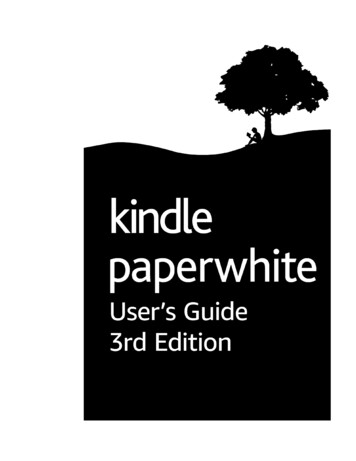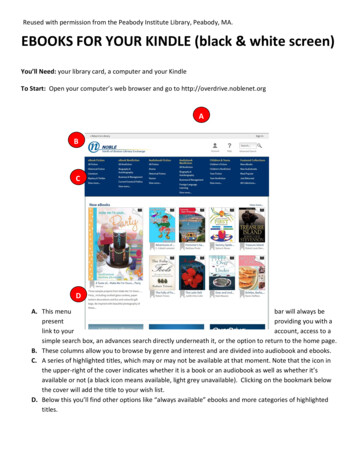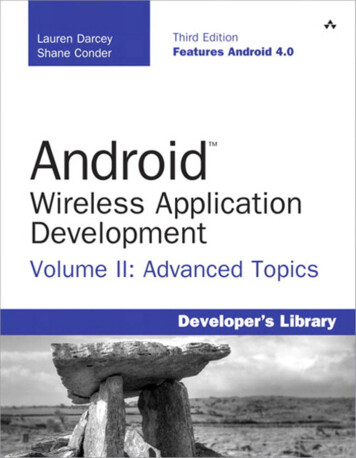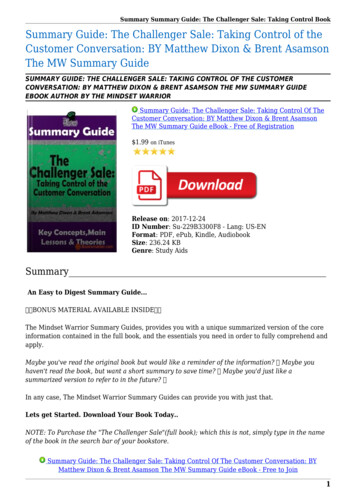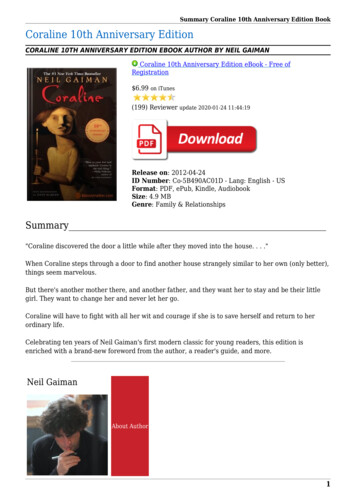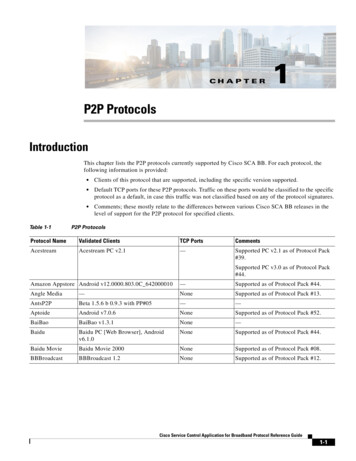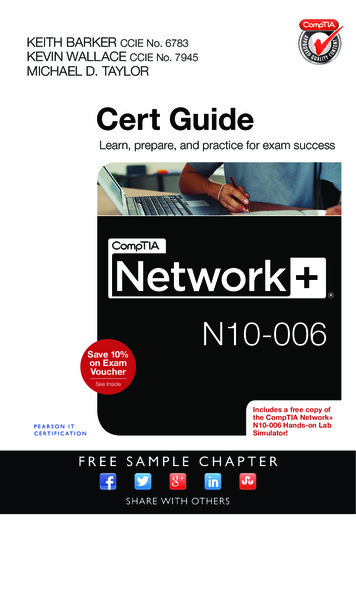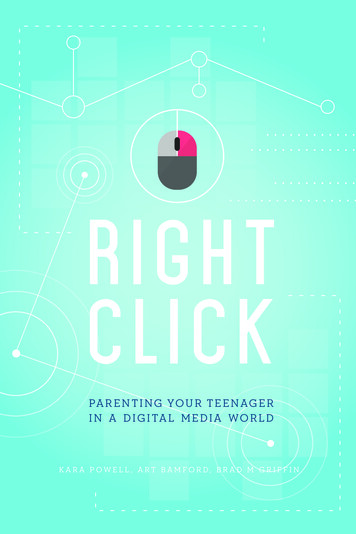
Transcription
Righ tC lickPA R E N T I N G YO U R T E E N AG E RI N A D I G I TA L M E D I A WO R L DK A R A P OW E L L , A R T BA M F O R D, B R A D M G R I F F I N
W H AT O T H E R S A R E S AY I N GABOUT RIGHT CLICKThe cry of every parent and church leader in this generation is “Howdo I help create media-safe homes?” Right Click is a wonderfulresource that gives practical answers to the most-often askedquestions about how to handle social media. I loved the sections onsetting limits and the importance of dealing with bullying and porn.This is my go-to book for parents.— Dr. Jim Burns, President, HomeWord, author of ConfidentParentingAs parents of two teenage boys, Right Click couldn’t be more timelyor relevant for us. We’re so glad to discover it. This highly accessiblebook is not only grounded in research, it’s immeasurably practical. Ifyou’re a parent, you’ll want to read this book—and you’ll be a betterparent because of it!—Drs. Les & Leslie Parrott, authors of Saving Your Marriage BeforeIt StartsMy favorite thing about this book is that it doesn’t take a doomand-gloom approach to technology. It recognizes the bad parts ANDthe good parts, providing a road map for the future.—Jon Acuff, New York Times Bestselling author of Do Over2
As a parent of teenagers, this is the book I wish I’d had ten yearsago before smartphones and social media challenged the skillsets ofparenting. The first wave of trials and triumphs have come to pass,and Right Click captures the best wisdom and research to help futureparents stand on the shoulders of those who have come before. Stealtheir wisdom and read this book; you’ll be glad you did.—Mark Matlock, Executive Director, Youth Specialties, author ofReal World ParentsAs parents, we find ourselves living on the “digital frontier.” Like thepioneers who crossed the country to settle the Wild West, every stepwe take into this new technological landscape moves us further andfurther into uncharted territory. Figuring out how best to navigate thejourney for our kids and for ourselves is not an option for parents; it’sa necessity. Right Click will serve you as a wise and valuable tool inyour digital parenting toolbox.—Dr. Walt Mueller, President, Center for Parent/YouthUnderstanding, author of Understanding Today’s Youth CultureThis is one of the first books I’ve read about technology that didn’tmake me feel defeated as a parent. Filled with practical suggestionsand rooted in research, the FYI team avoids the typical approachesthat vilify or glamorize digital connections. Raising culturallyintelligent kids requires this kind of redemptive approach totechnology.—Dr. David Livermore, cultural intelligence and global leadershipexpert and authorWise, practical, and fun to read. Parents will be delighted. And so willtheir kids.—Dr. Quentin Schultze, author, Center for Servant LeadershipCommunication3
FULLER YOUTH INSTITUTERight ClickParenting Your Teenager in a Digital Media WorldA Sticky Faith GuideCopyright 2015 by Kara Powell, Art Bamford, & Brad M. GriffinAll Rights ReservedSticky Faith is a trademark of the Fuller Youth Institute at Fuller TheologicalSeminary and is registered with the United States Patent and Trademark Office.Published in the United States of America byFuller Youth Institute, 135 N. Oakland Ave., Pasadena, CA 91182fulleryouthinstitute.orgISBN 978-0-9914880-5-6Unless otherwise noted, all scripture quotations are taken from THE HOLY BIBLE, NEWINTERNATIONAL VERSION , NIV Copyright 1973, 1978, 1984, 2011 by Biblica, Inc. All rights reserved. No part of this publication may be reproduced, stored in a retrievalsystem, or transmitted in any form or by any means—electronic, mechanical, photocopy,recording, or any other—except for those parts intended as distributable handouts ordigital resources, without the prior permission of the publisher.Cover and Interior Design: Macy Phenix Davis, Matthew SchulerFuller Youth InstituteCopy Editor: Dana WilkersonPrinted in the United States of America
For every parent wondering how to navigatethe maze of technology with their family.We’ve been there. We are there.Every day.Your willingness to ask the tough questionsinspires us to do the same.
R I G HTclickA STIC KY FAITH G UI DEPA R E N T I N G YO U R T E E N AG E RI N A D I G I TA L M E D I A WO R L DK A R A P OW E L L , A R T BA M F O R D, B R A D M G R I F F I NFuller Youth Institute Pasadena, California
8
TA B L E O F C O N T E N T SLOGIN[Preface]1Why Right Click?2Why do my kids constantly check their phones?3How can I help my family actually be together whenwe’re in the same room?4How can I supervise what my kids are saying andsharing without making them feel like they’re undersurveillance?5How can I help my kids become good digital citizens?6How (and when) can I gracefully take off the mediatraining wheels?APPENDIX:10 things every parent should knowabout gaming9
LOGIN [PREFACE]Please help us figure this stuff out.Tears in his eyes, our friend Tim confirmed for us that thisbook had to be written. His own experiences as a parent and aministry leader left him with more questions than answers, andmore frustration than resolution. When we pitched the ideaswe had been mulling over—the ones that have come to lifein the pages ahead—Tim’s emotional reaction cemented ourresolve to help parents find a way forward.Kara and Brad are both parents of teenagers, pre-teens, andelementary-aged kids. That means we’re knee-deep in thesame (and daily!) conversations you are with our own kids andwith other parents about digital technology. In fact, throughfocus groups and interviews, we listened to a host of parentsas we developed this resource. Their hopes, fears, and practicalideas for navigating media are woven into every chapter.Art isn’t a parent, but he has been tutoring us in technologyand digital media as a researcher who studies media, the wayswe use it in our culture, and the role it plays in teenagers’ faithformation. By serving as a youth ministry volunteer, he also hasbeen able to evaluate much of the research he’s conductedor reviewed firsthand to see what resonates most. We areincredibly grateful for his work quarterbacking this projectalongside us (and a lot of other fumbling parents just like us).Throughout the book, when we refer to “I” or “my,” we may bereferring to any of the three of us. It felt simpler to use justone voice rather than keep explaining who was talking.10
WHAT IS THIS RES OURCE ABOUT?Early on in this project, we reviewed a number of existingresearch and resources on parenting and digital media,hoping to find a few we could recommend. A lot of what wefound were resources trying to shoehorn responses to digitaltechnology into a mold that was cast for analog media severaldecades ago. (Don’t worry, we’ll explain what that means inchapter 1.)But like it or not, we can’t remove digital from our kids likea stain and get them to think about media and use it like wedo. That’s not the world they live in now, and it’s not the onethey’re going to live in as adults.A host of resources also exist that tell parents what to do aboutthe latest digital media fad rather than how to think aboutdigital media more comprehensively. Many of these resourcesare good, and they are useful in the moment. But relying onthis kind of approach can begin to feel like a game of Whacka-Mole for parents as new challenges keep popping up andchanging. The mallet that perhaps once worked now feelsclumsy and ineffective.We also can’t deny the fact that each of our kids is different.What works for our oldest when she’s fifteen won’t workfor our youngest by the time he’s fifteen. As parents, we getexhausted from tracking down new tools to try to understandthe latest device or new app our kids are obsessing over.11
prefaceFinally, we want to talk about media more with our kids, but wearen’t always sure how. And our kids can’t seem to articulateanything coherent—or in a language we understand. As we’llexplore in the coming pages, it turns out that we are living ina transitional phase in history. This means we as parents can—and should—have totally new conversations with our kids.We want to help you better understand where your kids arecoming from and muster up the courage to talk more about allof this. As St. Francis of Assisi has been paraphrased, Let us seekfirst to understand, then to be understood.1So we wrote this resource to help you think differently aboutdigital media, talk more with your family about it, and beinspired by the ideas of other parents navigating these samewaters day after day. A day rarely goes by in our families whennew questions and parenting decisions about technology don’tpop up. This book is as much about our own sanity as it isabout yours!For more resources to help build Sticky Faith in your family,visit stickyfaith.org. Look for free online features and extrasrelated to Right Click at rightclickbook.com!12
The stakes for how your family handles technology may behigher than you realize. One of the highlights of our researchon how families can build long-term faith—or what we callSticky Faith—has been the power of warm family relationships.Research indicates that children who feel close and connectedwith their parents are more likely to adopt their parents’faith.2 Every page in this book is geared to strengthen yourrelationship with your children, which in turn increases theodds that they will follow in your faith footsteps.So if you’re wondering How do I raise thoughtful wireless users in a “Hey, Siri” culture?What do I do when my eleven-year-old begs to get on socialmedia because “everybody else is already doing it”?How can I keep my teenager from becoming an Internet “troll”?Can someone just help me reclaim face-to-face conversation withmy kid again? or a host of other questions, hopefully this book will kickstart good dialogue. We end each chapter with questionsand suggestions for how you can both teach principles andimplement new practices in your family.We’re in this with you. Digital media isn’t our friend orour enemy. It’s just part of life now. Let’s chart a new pathtogether!13
prefaceTHE DATA:H OW MU CH A RE TE E NA G E R S U S IN G D I GI TA L M E D I A ?It is still very difficult to determine what is considered“normal” or average behavior when it comes to how youngpeople are using digital media, but we know parentswonder how their kids’ usage compares to others. Thefollowing statistics are not foolproof. They are also notmeant to be a measuring stick by which you evaluate yourkids. Instead, national averages can help us see the “bigpicture” changes that are happening in the lives of youngpeople all around us. According to the latest findings:392 percent of teenagers report going online atleast once per day. 24 percent of teens confessgoing online “almost constantly.”71 percent of teenagers use more than onesocial media platform to keep in touch withfriends.14
The median number of texts a teenager sendsand receives per day is 30, but that increases to50 for 15–17 year-old girls.73 percent of all teenagers have smartphones:68 percent of 13–14 year-olds and 76 percentof 15–17 year-olds.76 percent of teens ages 13–17 use socialmedia; 23 percent report being active on socialmedia every day.83 percent of young people who use socialmedia say it makes them feel more connectedto their friends’ lives, and 68 percent of youngpeople who are active on social media havehad people support them through tough orchallenging times through social media.15
01WHY RIGHT CLICK?
why right click?I T WA S E V E R YPA R E N T ’ SNIGHTMARECOME TRUE.he had sent and comparedthat to how many were on hisphone. Sure enough, she foundthat he had deleted severalmessages. After showing himthis evidence, Eric finallyadmitted that he had, in fact,sent the picture.“One afternoon the viceprincipal called me,” Tammysaid.1 “He overheard a rumorthat our son, Eric, had taken aphoto of a particular body partwith his phone and sent it to agirl in his class.”Unfortunately his confessiononly led to another frustratingargument. In Eric’s opinion,what he had done was “no bigdeal.” Tammy decided to call afriend who works for the localpolice department to set up ameeting. “Eric either didn’t getit or didn’t care—I needed todo something more than justtalk at him,” she explained. Ericexpected to sit through a quicklecture from their family friendat the precinct, but when theyarrived, he was whisked into aninterrogation room. A detectivesternly explained the possibleimplications of sending thesetypes of photos—which manystates view as distribution ofchild pornography.“I thought you might want totalk with him about it afterschool,” the vice principal toldthis utterly mortified mom.As you can imagine, Tammy’sson emphatically deniedsending the photo. They argued.Eric stood by his side of thestory and accurately remindedhis mom that he had neverbeen in trouble at schoolbefore. But Tammy, who hadalways felt like she was closeto Eric, knew she needed todig deeper. She checked thestatement from their serviceprovider to see how many texts18We asked Tammy, “So did helearn a lesson from that?”“You bet he did. All three of ourboys did.”
Tammy handled the incident admirably. But most of us have noidea what we’re supposed to do in situations like this. Kids havealways made mistakes while they’re growing up—that part isnormal. But as Tammy bemoaned, “This feels like a whole differentlevel.” Mistakes like these can have very serious consequences, andas parents this is the water we swim in every day with our kidsand their digital devices.“ I ’ D L I K E T O M E E T T H E G E N I US W H O T H O U G H T,‘ L E T ’S G I V E T E E NAG E B OYS A C A M E R A T H E Y C A NC A R RY A R O U N D W I T H T H E M A N D T H E N G I V ET H E M T H E A B I L I T Y T O S H A R E PH OT O S O N AW H I M . ’ TA L K A B O U T A CO LO S S A L LY B A D I D E A . ”—A nd r es , dad of t woIDENTIFY THE ISSUEWHAT DOES “RIGHT CLICK” MEAN?Technology is anything that was invented after you were born.—Alan Kay2For several decades, with what feels like an ever-increasingmomentum, our families have ushered one game-changingnew system, appliance, or device after another into ourhomes—some into our kitchens, others into our garages.But the ones that have caused parents some of the biggestheadaches are those that land directly in kids’ hands.319
why right click?We typically refer to a lotof our kids’ technology asmedia. The origin of the wordmedia essentially just means“middle.”4 And that fits, doesn’tit? Media is intended to be anintermediary that connectspeople with one another, butoften it ends up doing theopposite.5 It gets in the middleand drives a wedge between usinstead.More recently, we’ve added newwords to our media vocabulary:social and digital.In both cases, these wordsdifferentiate our newer devicesfrom the older analog oneswe’ve been using for a whilelike radio, TV, film, and recordedmusic. Analog and digital maylook and act pretty similar onthe surface, but they actuallyhave fundamentally differentprinciples behind how theywork (we’ll spare you thedetails).6 The bottom line isthat analog is a polite way ofsaying old media.When we say digital media,we’re talking about a puzzle ofcomputers, microchips, software,video games, and the Internetthat coalesced together as one20big phenomenon in the early2000s.7 Today this has grown toinclude laptops, smartphones,tablets, and any otherinteractive devices capableof connecting to the Internet.The two key distinctions thatseparate digital from analogare the ways in which digitalmedia is interactive andinterconnected.What has been so tricky forparents about digital mediais that while it may look andfeel a lot like the analog mediawe’re used to, it’s actually awhole new world. The move todigital media is a way biggerparadigm shift than movingfrom cassette tapes to CDs, asradical as that felt a couple ofdecades ago.8To use another analogy, wehaven’t just upgraded ourbaseball bat from wood toaluminum. We started playinghockey instead.New paradigms require wholenew perspectives to answer awhole new set of questions.But this is the rub: We onlyhave old-perspective answersto new-perspective questions.This is why it can feel so
disorienting. Scholars and experts used to be able to provideparents with straightforward and practical answers to their mediaquestions. Parents had the sense that there were certain right andwrong parenting strategies when it came to media. Those watersare far murkier today.Maybe you’ve felt this too. One mom we spoke with told us, “I’mso sick of the rules! We keep getting all this stuff from our kids’schools about what to do and it is usually totally unrealistic.It’s no help.” In fact, this year my kids’ school sent home onenewsletter encouraging us that kids shouldn’t have more than anhour of screen time a day, and another newsletter saying they aresupposed to spend at least an hour a day doing work on computerbased reading and math programs.What’s a parent supposed to do?21
why right click?NOT “ T H E ” R I G H T C L I C K ,BU T YO U R R I G H T C L I C KWhen we talk about digital media in this book, right click doesnot mean a universally “correct” or “proper” way to click. It’s aninvitation to step into the digital world of kids with greaterunderstanding and create a plan that’s right for your family.When we “right click” on our devices, a menu appears thatprompts us to choose what we want to do next. Throughoutthis book, we’ve sprinkled a host of options and suggestions,but ultimately you need to choose what fits your family best.We know families, but we don’t know your family.In the process of helping you devise a strategy that worksfor your family, we hope this resource helps you to step back,look at the big picture, and think about your options together.From this new perspective, you will hopefully find a handfulof suggestions that alleviate some of your family’s conflictor frustration over technology. If you have younger kids, youmight even implement new ideas now that will help lay thegroundwork for when they’re older.More than anything else, our prayer is that technology willmove from being something that drives your family apart tosomething that brings your family together.22
REFRAME OUR VIEWSHIF TING MENTAL MODELSO NC E U P O N A T I M E .Imagine a charming little village like the ones you see infairy tales. It is part of a kingdom within which citizens traveland trade. Everyone speaks the same language, uses thesame currency, marries within the same social circles, andholds the same values. Since the borders of the kingdom arewell defined, its citizens enjoy both stability and peace.Now imagine that one day the prince of this kingdom decidesto marry a princess from a faraway land. At first, this isexciting news! People feel a thrill as they watch the peoplefrom this exotic new culture parade through their town onthe way to the wedding. The royal couple even promises thatthis will be an era filled with all sorts of new opportunitiesthat benefit citizens of both countries.But after the honeymoon, the royal marriage slowly startschanging life across the kingdom—and life in our littlevillage—even more than anticipated. The culture that hasbeen treasured now has to adapt in order to accommodatenew patterns of life. People start adopting practices from anunfamiliar new culture. A shift this monumental takes years,or even decades, before the dust finally settles.T H E E N D.23
why right click?PRETTY UNSATISFYING ENDING, HUH?Well, this is where we live.9Centuries ago, when one kingdom was conquered by or unitedwith another, a long process of change would begin that touchedon almost every aspect of people’s lives. We are currently in themidst of a similar shift as our existing world slowly adopts andadapts to its new partner in the wake of the digital revolution. Weremember how things were and the excitement of the weddingday (Remember your first smartphone?). But now we find ourselvescaught in a world changing more rapidly than we imaginedpossible. The majority of marriages that end in divorce do sobetween the third and tenth year—that’s where we are with digitalmedia. There are good days and bad days. We’re not sure how wellthis is really going to work out.This presents us with quite a different set of challenges fromthose faced by our own parents and grandparents. The earliertransitions from print to radio, or from radio to television, weresignificant and had implications for how parents raised their kids.But these were all steps along the same path. Ours is a uniquechallenge because digital media has not simply taken the nextstep forward; it has leapt onto totally new ground.It is helpful to stop and let this sink in.So often we worry how we’re doing as parents when it comes tomedia and our kids, but we truly are trailblazers. If it feels likeyou’re making it up as you go along that’s because you are!It is also valuable to point out that our kids didn’t ask for this.They’re trailblazers too, but they just want to grow up safely andhappily. This is more of a burden than we realize. When one groupof researchers asked kids about their experiences online, theymentioned things like:24
“Propositions to meet from people I do not know.”—Boy, age twelve“One time I was looking for a game and rudepictures came on the computer, people withoutclothes on.”—Gi r l, a ge t e n“Pop up things where you have to buy something.”—Boy, a ge te n 1 0The digital world can be a scary and confusing place for kids. Asadults, we have perspectives of a world both with and withoutdigital media. Our kids may sense that we miss how things used tobe, but they’ll never understand why.They’re just trying to make sense of the only world they know.A TA L E O F T WOPERSPECTIVESKids are learning to understand and use media in radicallynew ways. The biggest stumbling block for parents is oftennot what we do, but how we think about media. When we failto understand how our kids think about it, our conversationsabout boundaries, rules, and good decisions get lost intranslation.25
why right click?THE FAU LT IN OUR STATSThroughout this book, we are providing research-basedbenchmarks to help you think about when and how to allowkids to begin using certain digital media. It is important thatwe include a caveat here. Based on the existing research, itis difficult for us to make these recommendations for threereasons:1.D I G I TA L M E D I A I S ST I L L R E L AT I V E LY N E W.It’s changing rapidly enough that there isn’t much solidresearch available yet. A few years ago, I heard a scholarpresent his recently completed Ph.D. dissertation at anacademic conference. He had done a rather brilliant study on MySpace. Immediately after he finished, every hand inthe room shot up, eager to ask the obvious question, “Whatabout Facebook?!” Now the questions would reflect themultitude of social media platforms.The kind of “media effects” research that is used to supportusage recommendations gets better and better as morescholars are able to weigh in, tinker with variables, andretest certain hypotheses in different contexts.112 . A LOT O F E X I ST I NG R E SE A RC H T R E AT SM I NO R S, CO L L E G E ST U D E N T S, O R PA R E N T SA N D A D U LT S A S SE PA R AT E CAT E G O R I E S.It doesn’t look at families as a whole or trace anyprogression from one developmental stage to the next.12This means that we do not yet have a clear sense of howmuch of what young people are doing online is just adigital version of them acting like adolescents and howmuch reflects the start of behaviors they will carry withthem into adulthood.26
3. T H I S I S E SPE C I A L LY T RU E W H E N I T CO M E ST O R E SE A RC H O N SE X , S O C I A L M E D I A , A N DYO U NG PE O PL E .Topics related to sex and young people are notoriouslydifficult to investigate.13 Most researchers steer clearof projects involving young people’s sexuality or sexualbehaviors because of all the approvals, permissions, andpaperwork involved. That’s why most of what we see inpopular media is based on informal online polls ratherthan actual empirical study.Even in the limited amount of studies we do have, itis difficult to trust the data. Imagine your kids beinginterviewed by a random adult stranger about their sexualbehaviors, identity, or attitudes. Do you think they wouldfeel comfortable or answer honestly? Does a seventeenyear-old boy respond differently to questions about his sexlife when talking with a young adult female interviewerversus an older male one? Totally! It is very difficult toaccount for how the various age- and gender-relateddynamics in these studies skew the results.People in our position, translating this type of researchinto resources, don’t do parents any favors by reducingcomplex studies into deceivingly straightforward statistics.We advise parents to take what they see in the news orhear about from others with a grain of salt and make surethey pay close attention to their own families.We spoke about this with parents, and one mom, the wifeof a research scientist, summed it up quite nicely: “Wedon’t worry about all that. They’ve done studies on kids,but they haven’t done a study on our kids.”27
why right click?NAME THE GOALRELATIONSHIPS, NOT JUST R U LESHaving a big-picture grasp ofwhat makes digital technologyso different from what’s comebefore helps us as parentsto be equipped to deal withthe questions and concernswe have now and be able toaddress future issues as theyarise.14 The goal is to havegreat relationships with ourkids. Media will be in themiddle of that somehow.Rather than a divider, we wantit to be a middle ground—acommon ground where familiesconnect.grandfathers never playedthem. But now I still love themand so do the kids, and thathas been a big connection forus. We get to do it together.”Nicolas noticed how, alongsidethe challenges we face astrailblazers, we also have a lotof great new opportunities toconnect with our kids.Megan, a mom from Michigan,actually thanked me at theend of our interview for achance to pause and thinkabout this. “You know, we’vebeen struggling a lot lately,One dad we spoke with madeand I forget sometimes howa helpful observation aboutwe do enjoy technologyhis own video gaming habits.together and even benefit fromNicolas said, “It’s funny because it. I’m grateful for that. I getI always assumed I wouldfrustrated at times, but at theoutgrow video games at aend of the day, am I glad wecertain point. I guess I thought have this stuff? Definitely.”that because my dad and my28
“I was struggling recently with some things, and mynineteen year-old sent me a lot of encouragementsby text. I thought, ‘Wow, this has come full circle. I’mgetting fed back spiritually now.’ I try to tell parentsthat, because I think it’s encouraging to know that itdoes come full circle.” —Amy, mom o f t h r e eRIGHT CLICKCOVENANT RELATIONSHIPSMany families, including our own, have found common mediaground through covenant agreements. A covenant or “mediacontract” gives your family an opportunity to craft somelanguage that describes how all of you will—and will not—usemedia. It helps create a consistent, shared way of life together—one in which everyone feels heard, valued, and where boundariesexist to connect us, not separate. Through the course of thisbook, we hope to help you create a covenant that is tailor-madefor your unique family—your own “common media ground.”If an actual written covenant doesn’t seem like a good fit foryour family, that’s totally fine. One mom of now college-agedkids told us, “We didn’t do a written covenant, but I do think wehad a kind of verbal covenant and consensus about what ourexpectations were.” That is the goal here: consistent consensusabout your family’s expectations. In many cases, our promptscenter around phrases like “Ask your kids ” and “Think abouthow ” Intentional reflection and conversation about media canitself provide a valuable “restart” for our current practices.29
why right click?At points we will also suggest some changes in how weparents live out our own media use. That’s the hard medicineto swallow here. As different as digital media is, our kids stillobserve and imitate how we use it. One of the things welearned through our Sticky Faith research is applicable tomedia: You tend to get what you are.15 What we mean is thatour faith is often the best predictor of our kids’ faith. When itcomes to digital media, we can safely assume that a similarprinciple is at work.16 But our modeling is often unspoken,evolving, and involves our everyday lives and work.I T TA K E S A N E T WO R KWhen we sat down with parents in focus groups expectingto get some great questions and practical ideas, we oftenfound that simply having a discussion about digital media wasextremely helpful for parents. It provided an opportunity toshare tips and strategies, many of which ended up in this book.Several of these church-based parent groups also realizedthat their kids were part of tightly connected social networksonline, but they as parents were not.With analog media, families only felt responsible for the mediadecisions made in their own homes. In one sense, it was an ageof “every family for themselves.” Digital media has connectedus to other families locally and globally in ways we’ve neverbefore imagined. That also means new doors have openedfor parents to support each other more than we may realize.The more tightly knit and well connected your family’s socialnetwork is both on and offline, the easier it will be to dealwith digital media. We heard this theme in our conversationswith parents. So as you read this book and think about theimplications for your own family, consider expanding theseconversations to include others, or even think about using thisresource as a group study guide.30
At the end of each chapter, we have
—Drs. Les & Leslie Parrott, authors of Saving Your Marriage Before It Starts My favorite thing about this book is that it doesn’t take a doom-and-gloom approach to technology. It recognizes the bad parts AND the good parts, providing a road map for the future. —Jon Acuff, New York T
